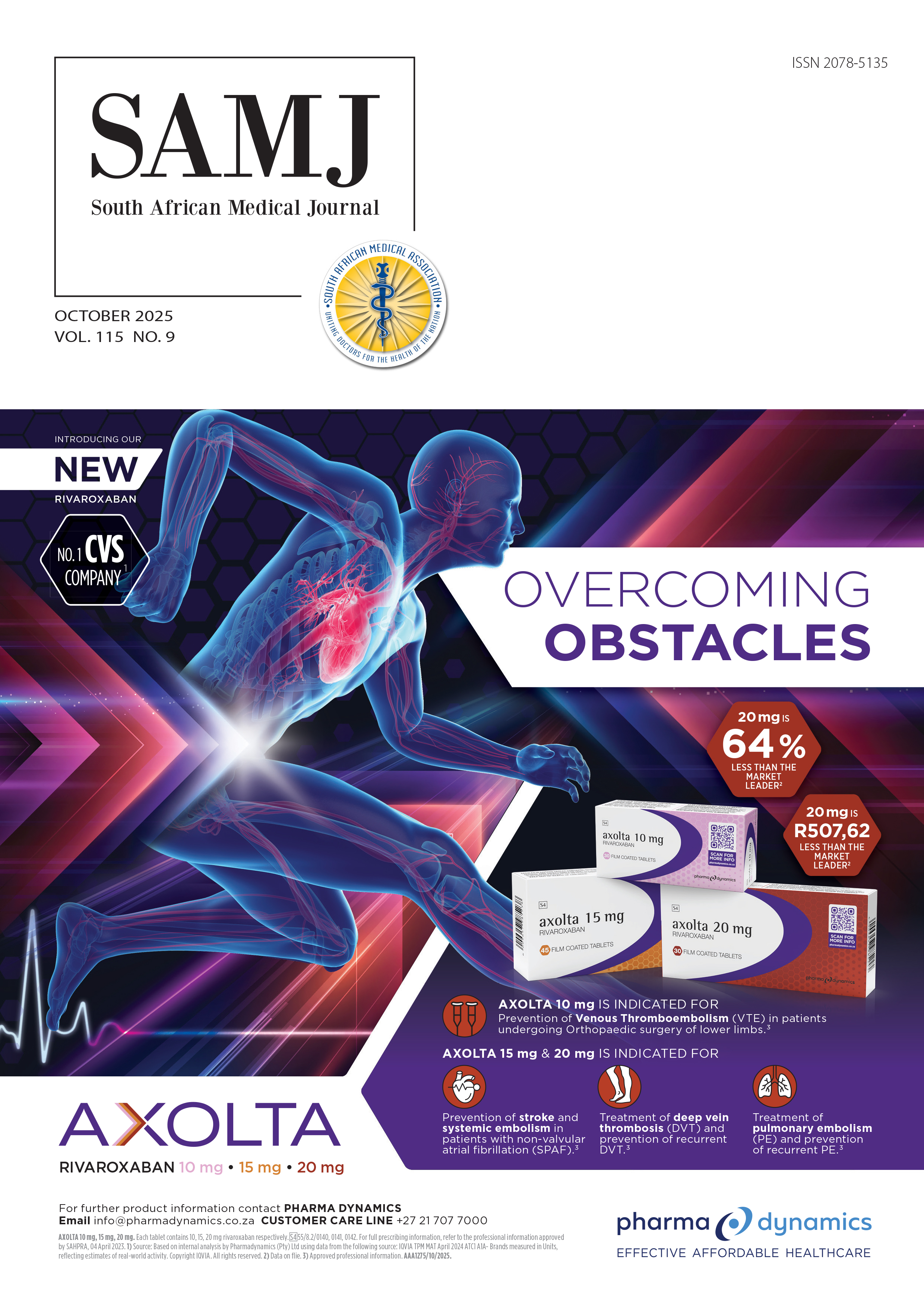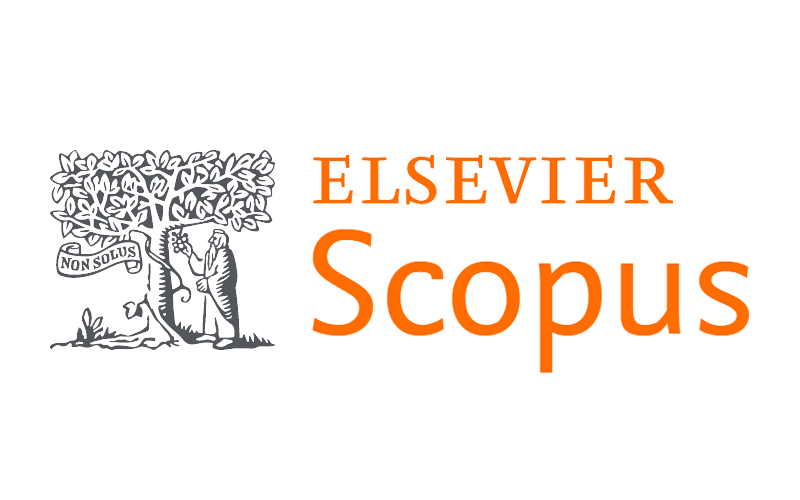Thrombosis and bleeding outcomes with warfarin conversion to rivaroxaban during the COVID-19 pandemic
DOI:
https://doi.org/10.7196/SAMJ.2025.v115i9.3503Keywords:
Thrombosis, bleeding, covid-19 infection, warfarin, rivaroxabanAbstract
Background. In 2020, during the coronavirus disease 2019 (COVID‐19) outbreak, eligible patients were converted from warfarin to rivaroxaban therapy to limit the transmission of COVID‐19 infection.
Objective. To assess the thrombosis and bleeding outcomes associated with converting patients on warfarin therapy to rivaroxaban during the COVID‐19 pandemic.
Methods. A retrospective audit was performed that identified 190 participants with venous thromboembolism (VTE) and 112 participants with non‐valvular atrial fibrillation at the anticoagulation clinic service at Charlotte Maxeke Johannesburg Academic Hospital, South Africa. Participants were converted to rivaroxaban 20 mg for a median (interquartile range) period of 4 (2) months between April and October 2020. Follow‐ups were conducted telephonically and face‐to‐face on conversion back to warfarin. Rates of COVID‐19 infections, bleeding and thrombosis were objectively confirmed.
Results. The COVID‐19 infection rate among participants was 3.3% (95% confidence interval (CI) 1.6 ‐ 6.0), with five (1.7%) hospital admissions and two (0.7%) COVID‐19‐related deaths. The deaths occurred in one participant on rivaroxaban, and in another after switching back to warfarin. One week after switching to rivaroxaban, the rate of clinically relevant non‐major bleeding was 0.7% (95% CI 0.02 ‐ 2.54), while minor bleeding occurred at a rate of 9.2% (95% CI 6.16 ‐ 13.40). No major bleeding events were reported, and bleeding rates on rivaroxaban were not significantly higher compared with warfarin. Additionally, two (0.7%) myocardial infarctions were recorded. One occurred on rivaroxaban and the other after switching back to warfarin. A single (0.3%) VTE presenting as a newly diagnosed pulmonary embolism was reported in a participant on rivaroxaban.
Conclusion. This study provides practical insights regarding the conversion of eligible participants from warfarin to rivaroxaban during the first wave of COVID‐19, with the aim of informing future public health interventions in similar crisis settings.
References
1. Cucinotta D, Vanelli M. WHO declares COVID‐19 a pandemic. Acta Biomed 2020;91(1):157‐160.
https://doi.org/10.23750/abm.v91i1.9397
2. WorldHealthOrganization.Coronavirusdisease(COVID‐2019)situationreports.Geneva:WHO,2020. https://www.who.int/emergencies/diseases/novel‐coronavirus‐2019/situation‐reports/ (accessed 4 July 2020).
3. Abdool Karim SS. The South African response to the pandemic. N Engl J Med 2020;382(24):e95.
https://doi.org/10.1056/NEJMc2014960
4. Nussbaumer‐Streit B, Mayr V, Dobrescu AI, et al. Quarantine alone or in combination with other public health measures to control COVID‐19: A rapid review. Cochrane Database Syst Rev 2020;4(4):CD013574. https://doi.org/10.1002/14651858.CD013574
5. Semakula JR, Kisa G, Mouton JP, et al. Anticoagulation in sub‐Saharan Africa: Are direct oral anticoagulants the answer? A review of lessons learnt from warfarin. Br J Clin Pharmacol 2021;87(10):3699‐3705. https://doi.org/10.1111/bcp.14796
6. Conway SE, Hwang AY, Ponte CD, Gums JG. Laboratory and clinical monitoring of direct acting oral anticoagulants: What clinicians need to know. Pharmacother 2017;37(2):236‐248. https://doi. org/10.1002/phar.1884
7. Noubiap JJ, Kamtchum‐Tatuene J. Addition of direct oral anticoagulants to the World Health Organization model list of essential medicines for the treatment of atrial fibrillation: An African perspective. Br J Clin Pharmacol 2022;88(7):3035‐3038. https://doi.org/10.1111/bcp.15226
8. Makam RCP, Hoaglin DC, McManus DD, et al. Efficacy and safety of direct oral anticoagulants approved for cardiovascular indications: Systematic review and meta‐analysis. PLoS ONE 2018;13(5):e0197583. https://doi.org/10.1371/journal.pone.0197583
9. Fredman D, McNeil R, Eldar O, Leader A, Gafter‐Gvili A, Avni T. Efficacy and safety of rivaroxaban versus apixaban for venous thromboembolism: A systematic review and meta‐analysis of observational studies. J Thromb Thrombolysis 2024;57(3):453‐465. https://doi.org/10.1007/s11239‐023‐02926‐3
10. Mamas MA, Batson S, Pollock KG, et al. Meta‐analysis comparing apixaban versus rivaroxaban for management of patients with nonvalvular atrial fibrillation. Am J Cardiol 2022;166:58‐64. https://doi. org/10.1016/j.amjcard.2021.11.021
11. Witt DM, Clark NP, Kaatz S, Schnurr T, Ansell JE. Guidance for the practical management of warfarin therapy in the treatment of venous thromboembolism. J Thromb Thrombolysis 2016;41(1):187‐205. https://doi.org/10.1007/s11239‐015‐1319‐y
12. Kaatz S, Ahmad D, Spyropoulos AC, Schulman S; Subcommittee on Control of Anticoagulation. Definition of clinically relevant non‐major bleeding in studies of anticoagulants in atrial fibrillation and venous thromboembolic disease in non‐surgical patients: Communication from the SSC of the ISTH. J Thromb Haemost 2015;13(11):2119‐2126. https://doi.org/10.1111/jth.13140
13. National Institute for Communicable Diseases. COVID‐19 testing summary – week 52. NICD, 2020. https://www.nicd.ac.za/wp‐content/uploads/2020/12/COVID‐19‐Testing‐Summary‐Week‐52‐ Dec‐2020.pdf (accessed 12 January 2021).
14. Steffel J, Collins R, Antz M, et al; external reviewers. 2021 European Heart Rhythm Association practical guide on the use of non‐vitamin K antagonist oral anticoagulants in patients with atrial fibrillation. Europace 2021;23(10):1612‐1676. https://doi.org/10.1093/europace/euab065
15. Granger CB, Alexander JH, McMurray JJ, et al.; ARISTOTLE Committees and Investigators. Apixaban versus warfarin in patients with atrial fibrillation. N Engl J Med 2011;365(11):981‐992. https://doi. org/10.1056/NEJMoa1107039
16. Connolly SJ, Ezekowitz MD, Yusuf S, et al.; RE‐LY Steering Committee and Investigators. Dabigatran versus warfarin in patients with atrial fibrillation. N Engl J Med 2009;361(12):1139‐1151. https://doi. org/10.1056/NEJMoa0905561
17. Mahaffey KW, Wojdyla D, Hankey GJ, et al. Clinical outcomes with rivaroxaban in patients transitioned from vitamin K antagonist therapy: A subgroup analysis of a randomised trial. Ann Intern Med 2013;158(12):861‐868. https://doi.org/10.7326/0003‐4819‐158‐12‐201306180‐00003
18. Norby FL, Bengtson LGS, Lutsey PL, et al. Comparative effectiveness of rivaroxaban versus warfarin or dabigatran for the treatment of patients with non‐valvular atrial fibrillation. BMC Cardiovasc Disord 2017;17(1):238. https://doi.org/10.1186/s12872‐017‐0672‐5
19. StevensSM,WollerSC,KreuzigerLB,etal.AntithrombotictherapyforVTEdisease:Secondupdateof the CHEST guideline and expert panel report. Chest 2021;160(6):e545‐e608. https://doi.org/10.1016/j. chest.2021.07.055
20. Lip GYH, Banerjee A, Boriani G, et al. Antithrombotic therapy for atrial fibrillation: CHEST guideline and expert panel report. Chest 2018;154(5):1121‐1201. https://doi.org/10.1016/j.chest.2018.07.040
21. Martin KA, Beyer‐Westendorf J, Davidson BL, Huisman MV, Sandset PM, Moll S. Use of direct oral
anticoagulants in patients with obesity for treatment and prevention of venous thromboembolism: Updated communication from the ISTH SSC Subcommittee on Control of Anticoagulation. J Thromb Haemost 2021;19(8):1874‐1882. https://doi.org/10.1111/jth.15358
22. Homan K, Seeley R, Fisher L, et al. Safety of direct‐acting oral anticoagulant (DOAC) prescribing: OpenSAFELY‐TPP analysis of 20.5 million adults’ electronic health records. BJGP Open 2024;8(2):BJGPO.2023.0163. https://doi.org/10.3399/BJGPO.2023.0163
23. OpenSAFELY Collaborative; Curtis HJ, MacKenna B, Walker AJ, et al. OpenSAFELY: Impact of national guidance on switching anticoagulant therapy during COVID‐19 pandemic. Open Heart 2021;8(2):e001784. https://doi.org/10.1136/openhrt‐2021‐001784
24. Alkhameys S, Barrett R. Impact of the COVID‐19 pandemic on England’s national prescriptions of oral vitamin K antagonist (VKA) and direct‐acting oral anticoagulants (DOACs): An interrupted time series analysis (January 2019 ‐ February 2021). Curr Med Res Opin 2022;38(7):1081‐1092. https://doi. org/10.1080/03007995.2022.2078100
Downloads
Published
License
Copyright (c) 2025 C-Y Wang, E Schapkaitz, S Louw, B Jacobson

This work is licensed under a Creative Commons Attribution-NonCommercial 4.0 International License.
Licensing Information
The SAMJ is published under an Attribution-Non Commercial International Creative Commons Attribution (CC-BY-NC 4.0) License. Under this license, authors agree to make articles available to users, without permission or fees, for any lawful, non-commercial purpose. Users may read, copy, or re-use published content as long as the author and original place of publication are properly cited.
Exceptions to this license model is allowed for UKRI and research funded by organisations requiring that research be published open-access without embargo, under a CC-BY licence. As per the journals archiving policy, authors are permitted to self-archive the author-accepted manuscript (AAM) in a repository.
Publishing Rights
Authors grant the Publisher the exclusive right to publish, display, reproduce and/or distribute the Work in print and electronic format and in any medium known or hereafter developed, including for commercial use. The Author also agrees that the Publisher may retain in print or electronic format more than one copy of the Work for the purpose of preservation, security and back-up.





